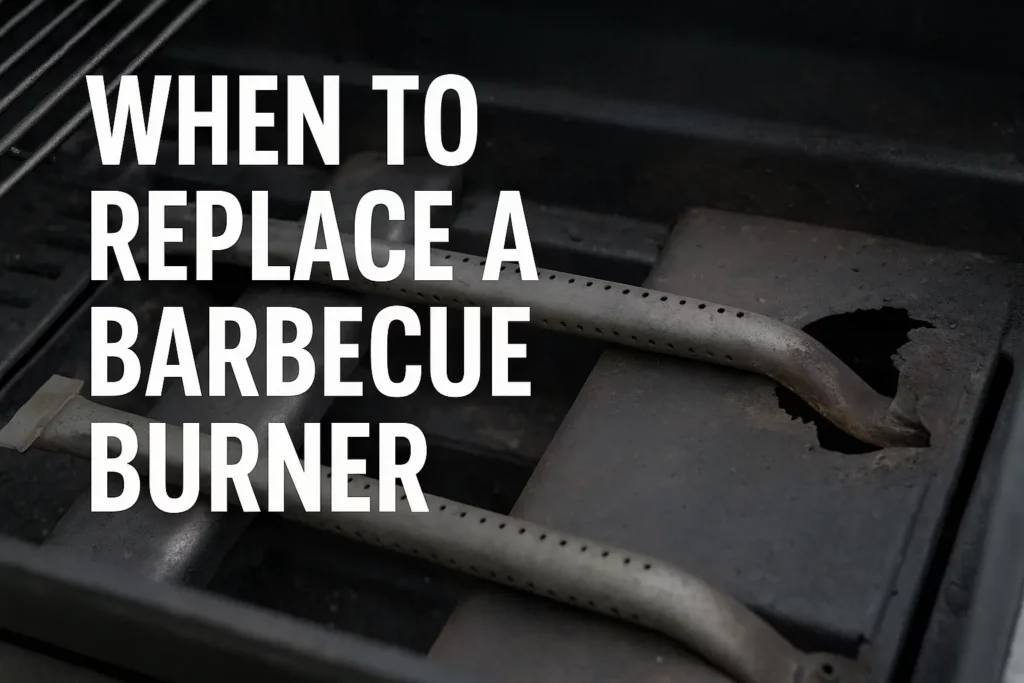This post may contain affiliate links. If you use these links to buy something we may earn a small commission. Thanks.
Nothing spoils a good cookout like a grill that won’t heat properly or flames that dance unevenly across your barbecue. When the burgers are undercooked on one side and scorched on the other, chances are the real culprit is your burner. A barbecue burner, often overlooked, is one of the most critical components of your grill and when it begins to fail, your grill’s performance quickly follows.
But how do you know when it’s time to stop scrubbing and start replacing? This guide will walk you through the signs that your burner is past its prime, what to look for during inspection, and why timely replacement matters for both safety and cooking success.
Introduction
Whether you’re a weekend warrior at the grill or a year-round barbecue enthusiast, your grill’s burner plays a major role in producing consistent, controlled heat. Over time, burners suffer wear and tear due to repeated exposure to intense heat, grease buildup, moisture, and even insects nesting in the tubes.

If not addressed promptly, a faulty burner doesn’t just lead to bad cooking results—it can become a fire hazard. That’s why understanding when to replace a barbecue burner is essential. It’s not just a matter of performance; it’s a matter of safety and efficiency.
Understanding the Role of a BBQ Burner
Before diving into signs of replacement, it helps to understand what your BBQ burner actually does.
What a Burner Does
The burner is responsible for distributing gas and creating an even flame that cooks your food. In gas grills, it works in tandem with a regulator and valve system to provide controlled flames through evenly spaced ports. This ensures consistent heat throughout the cooking surface.
Common Burner Types
- Straight tube burners: Common in rectangular grills
- U-shaped burners: Loop-shaped for better coverage in compact grills
- H-shaped burners: Feature two parallel tubes connected by a horizontal line
- Infrared burners: Use radiant heat, common in premium grills
- Rotisserie/back burners: Usually found in higher-end or multi-burner models
Each of these types has a slightly different wear pattern, but all are vulnerable to the same root causes of deterioration: corrosion, clogging, and metal fatigue.
Average Lifespan of a BBQ Burner
Understanding the expected life of a BBQ burner helps you prepare for maintenance and anticipate when a replacement might be needed.
Burner Lifespan by Material:
| Burner Material | Average Lifespan |
|---|---|
| Regular Steel | 2 to 4 years |
| Stainless Steel | 5 to 10 years |
| Cast Iron or Brass | 5 to 7+ years |
| Ceramic Infrared | 6 to 10 years |
These estimates can vary based on frequency of use, environmental exposure (e.g., coastal or humid climates), and how well the grill is maintained.
Real-world tip: Even premium burners won’t last their full lifespan if the grill is left uncovered outdoors all year.
Key Signs It’s Time to Replace Your BBQ Burner
Don’t wait until your grill completely gives out before replacing a faulty burner. Here are clear indicators it’s time for a change:
1. Uneven Flame or Cold Spots
A burner in good condition will emit a strong, even flame across all ports. If you notice large gaps or certain areas with little to no flame, the burner may be partially blocked or eroding internally.
2. Yellow or Orange Flames
Blue flames indicate a proper gas-to-air ratio. When flames turn yellow or orange, it’s often a sign that the burner is not mixing air and gas properly usually due to rust, blockage, or wear.
3. The Burner Won’t Ignite or Keeps Going Out
If ignition is delayed, fails entirely, or goes out shortly after lighting, your burner may have internal damage, gas flow issues, or rusted ignition ports.
4. Visible Cracks, Holes, or Rust
Any visible structural damage—such as holes in the burner tube or deep rust pitting—means the burner can no longer perform efficiently. Holes can cause uneven flames or dangerous flare-ups.
5. Flames Erupt from Odd Places
Are flames coming out of the sides or base of the burner? That’s a serious red flag. It typically means there are internal cracks or breaks in the burner, allowing gas to escape unpredictably.
6. Takes Much Longer to Preheat
If your grill once reached 500°F in under 10 minutes but now barely climbs past 300°F, poor burner performance could be to blame.
7. Excessive Flare-Ups or Inconsistent Heat
When heat varies wildly and food burns unpredictably, the burner may be partially clogged or damaged, leading to uncontrolled flare-ups.
When Cleaning or Repairs Aren’t Enough
Grill burners often suffer from minor issues like clogged ports or soot buildup. These can typically be addressed with a wire brush or cleaning rod. However, if cleaning no longer solves the problem, it may be time to replace.
When Cleaning Won’t Work:
- Burner holes are rusted out
- Metal flakes off when cleaning
- Clogs persist even after multiple cleanings
- Burner won’t align with gas valve anymore
Comparing Repair Effort to Replacement:
- Cleaning time: 30–45 minutes, often with modest results
- New burner cost: $15–$70
- Replacement time: 20–30 minutes, with immediate improvement in performance
When repairs become frequent or unreliable, replacement becomes the better option both in time and performance.
How to Inspect a Burner for Replacement
Regular inspection is key to identifying failing burners before they ruin your cookout. Here’s how to do it properly.
What You’ll Need:
- Screwdriver or wrench
- Flashlight
- Wire brush or pipe cleaner
- Safety gloves
Step-by-Step Burner Inspection:
- Turn Off Gas Supply: Disconnect the propane tank or shut off the natural gas line.
- Remove Cooking Grates and Flame Tamers: This exposes the burner area.
- Visually Inspect Burner Tubes: Look for rust, cracks, missing sections, or discoloration.
- Use Flashlight to Inspect Inside: Shine light through the burner ports to check for internal obstructions or corrosion.
- Brush Off Debris: Use a wire brush to gently clean the burner ports and see how well they hold up.
- Check Igniter Ports: Make sure ignition holes or wires are clear and undamaged.
If the burner looks compromised even after cleaning replace it rather than risk unsafe grilling.
Safety Risks of Delaying Burner Replacement
Delaying replacement might seem harmless, but there are real dangers associated with operating a grill with failing burners.
1. Uneven Cooking
When burners don’t distribute heat properly, you run the risk of undercooked meats or charred exteriors with raw centers. This is a major food safety issue.
2. Gas Leaks
Rust holes or cracks can redirect gas flow to places it shouldn’t go, increasing the risk of uncontrolled flames or explosions.
3. Fire Hazards
A compromised burner can ignite grease in unexpected areas, including beneath the grill or inside the firebox, putting your home and family at risk.
4. Damage to Grill Components
Poor burner performance can overheat or warp other components, including flame tamers, heat plates, or even the grill lid. This accelerates wear across the entire grill.
Choosing the Right Replacement Burner
Not all burners are universal, and installing the wrong one can create new problems. Always choose a replacement that matches your grill’s specs.
Matching by Brand & Model
- Look for your grill’s model number (usually on a plate near the gas tank area)
- Use OEM parts when possible
- Cross-reference with third-party suppliers if needed
OEM vs. Aftermarket Burners
- OEM (Original Equipment Manufacturer): Guaranteed fit, often pricier
- Aftermarket: May be cheaper, but ensure correct size, shape, and compatibility
Material Matters
- Choose stainless steel or brass for longer lifespan
- Avoid low-grade steel if you live in humid or coastal climates
- Consider investing in infrared burners for higher efficiency if upgrading
Conclusion
Knowing when to replace a barbecue burner is crucial to keeping your grill safe, efficient, and ready for any backyard gathering. Burners wear out from normal use, but by watching for signs like uneven flames, rust, or slow ignition, you can catch issues before they ruin your meal—or worse, start a fire.
Don’t wait until your grill fails during your next cookout. Inspect your burners regularly, clean them properly, and replace them as needed. It’s a small investment that pays off in better-tasting food, safer cooking, and a longer-lasting grill.
FAQs
Q1: Can I still use my grill if only one burner is bad?
A: Technically, yes—but you’ll get uneven heat, and the remaining burners may work harder and fail faster. It’s best to replace faulty burners as soon as possible.
Q2: Should I replace all burners at once?
A: If multiple burners are the same age and one has failed, it’s smart to replace them all for consistent performance.
Q3: How often should I inspect my BBQ burner?
A: Inspect your burners at least once every grilling season, and more frequently if you grill year-round.
Q4: What causes burner ports to clog?
A: Grease, food particles, insects, and corrosion are common culprits. Using a grill cover and cleaning regularly helps prevent blockages.
